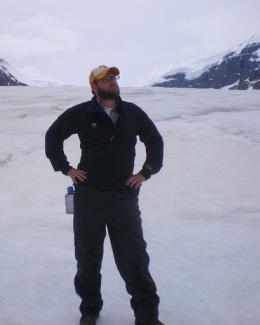The ORNL DAAC gathers, processes, archives and distributes information on key land processes, including the shifting ecological and geomorphological features of the U.S. Atchafalaya and Terrebonne basins gathered by the NASA Delta-X mission shown here. Credit: NASA Delta-X
In 1993 as data managers at the Department of Energy’s Oak Ridge National Laboratory began compiling observations from field experiments for the National Aeronautics and Space Administration, the information fit on compact discs and was mailed to users along with printed manuals. This year at its 30th anniversary, the ORNL Distributed Active Archive Center for Biogeochemical Dynamics, or ORNL DAAC, manages nearly 300 terabytes of data, almost all of which is available online through NASA’s Earthdata Cloud.
The ORNL DAAC serves as the primary repository for data from NASA’s Terrestrial Ecology program and its Carbon Cycle Science and Ecosystems focus area, centered on terrestrial biogeochemistry and ecological dynamics observations. Users have access to a wide range of sophisticated software tools and services to visualize and analyze the free, publicly available data without needing to download it.
The many projects supplying data to the ORNL DAAC include field campaigns, such as NASA’s Arctic-Boreal Vulnerability Experiment and a new project called Biodiversity Survey of the Cape that will measure biodiversity along the Cape of South Africa. The ORNL DAAC also manages data from multiple different airborne campaigns, such as the Atmospheric Carbon and Transport – America project, and data from modeling studies, such as the Database of Road Transportation Emissions.
Science themes for the ORNL DAAC data products include arctic ecosystems, biomass, carbon cycle, climate, fire, hydrology and cryosphere, land use and human dimensions, soils, and vegetation and forests.
The ORNL DAAC is one of 12 DAACs that are part of NASA’s Earth Observing System Data and Information System, or EOSDIS. The DAACs process, archive, document and distribute data from NASA’s past and current Earth-observing satellites and field measurement programs for use by scientists around the world seeking to understand and protect our planet.
“Most of the DAACs primarily archive and distribute data from NASA satellites, but those satellite data products are based on measurements made on the ground and in the air. We specialize in working with the many different research groups who go out into the world around us to collect that ground-based and airborne data,” said Bruce Wilson, manager for the ORNL DAAC and lead for the lab’s Remote Sensing and Environmental Information group.
The ORNL DAAC’s first orbital-derived data experience was supporting the NASA Global Ecosystem Dynamics Investigation, or GEDI, instrument attached to the International Space Station. GEDI provides estimates of aboveground biomass density around the world.
The ORNL DAAC also stewards data from three NASA airborne facility instruments: the AVIRIS-C and AVIRIS-NG spectrometers and the MODIS/ASTER airborne simulator, in addition to publishing data from other airborne campaigns.
Daymet Daily Surface Weather Data is the ORNL DAAC’s most downloaded dataset. It provides gridded estimates of daily weather parameters for North America, Hawaii and Puerto Rico for 1980 through 2022. This dataset is updated annually and is based on models developed by ORNL Environmental Sciences Division researchers.
Better data for better environmental solutions
“The ORNL DAAC along with the rest of NASA's EOSDIS is at the cutting edge and in many ways a leader in providing end-to-end management of NASA Earth science data,” said Michele Thornton, geospatial technical professional for ORNL DAAC who works on the Daymet archive. “Here at the ORNL DAAC, we have a specific emphasis on terrestrial and ecological data that is often acquired by field and sub-orbital campaigns. Being the comprehensive archive for those data allows for long-term access critical to better understanding Earth processes.”
The ORNL DAAC is a FAIR repository, meeting the principles of making data findable, accessible, interoperable and reusable as outlined by the GO FAIR initiative. “We have both the mission to publish the data and to help our user community make use of the information,” Wilson said. “For instance, many field ecologists are not remote sensing specialists. So the work of interpreting and making accessible remote sensing data to our communities is a part of our mission.”
ORNL DAAC staff routinely provide tutorials, workshops and webinars to advise users on tools and resources to extract data to support their science. The center maintains an archive of these learning resources for users to access anytime.
The ORNL DAAC also tracks how the data it publishes are cited, both to help understand the impact of the center and help the scientists who produced that data report the impact of their work. In 2022, ORNL DAAC datasets were cited in nearly 350 scientific publications, and is expected to rise to about 450 publications this year.
The ORNL DAAC has an estimated 55,000 users, and it has doubled the volume of data it has archived in each of the past two years.
“I believe that better data leads to better solutions,” said Debjani Singh, an ORNL research scientist who works with the center. “I along with my colleagues provide access to that better data that can be used for better solutions to complex environmental problems.”
Thornton said she gets the most reward from working with the research community and “feeling like we make a difference in their scientific investigations. This works from both directions — from researchers who provide us with data that is curated, archived and distributed by NASA Earthdata to students and researchers who discover and use data and services that enable their studies.”
A look ahead: Earthdata Cloud migration
The center collaborates with a 15-member user working group from various institutions around the country to ensure that data represent the scientific interests of the community and to provide guidance on the ORNL DAAC’s strategy and priorities.
Moving into the future, ORNL DAAC is increasing the open science value of the data it manages and increasing the interoperability of that data with data from other DAACs by migrating to NASA’s Earthdata Cloud. The center has already migrated over 98% of its data into this system and is working to make that data more interoperable with Earthdata Cloud data visualization and analysis tools and services. The ORNL DAAC is also working with the other DAACs and the broader NASA Earth Science Data Systems program to help users make full use of Earthdata Cloud capabilities.
“Earthdata Cloud will make it easier for users to access, interpret and analyze data without having to download it,” Wilson said. With the full migration, “we’ll equip people to focus on their science rather than the incantations necessary to manipulate and work with these large data,” he said.
The migration to the Earthdata Cloud “is an opportunity and a challenge because we’re rethinking how to move out of the download-and-analyze mode of work to an analysis-ready, cloud-optimized system that can work seamlessly for data across all 12 DAACs,” Wilson said.
“We are increasing the value of ecosystem data by making them more accessible, interoperable and reusable by a broader community of users, including the general public,” said Yaxing Wei, geospatial information scientist with ORNL DAAC.
The ORNL DAAC’s job, Wilson said, “is to make sure that the value of the investment that NASA has made in its capabilities and data collection is as fully realized as possible. We’re providing the data about how the world has changed and how it may change in the future.”
“The Earth Observing System at NASA is becoming a more active participant in how the science is done,” Wilson said. “We’re not just saying, ‘Hey, we’ve made the measurements and here’s the data.’ It’s how we as a program enable science. The biggest impact is how we help the world take full advantage of the irreplaceable data that NASA has collected about the Earth system.”
UT-Battelle manages ORNL for the Department of Energy’s Office of Science, the single largest supporter of basic research in the physical sciences in the United States. The Office of Science is working to address some of the most pressing challenges of our time. For more information, please visit energy.gov/science. —Stephanie Seay








